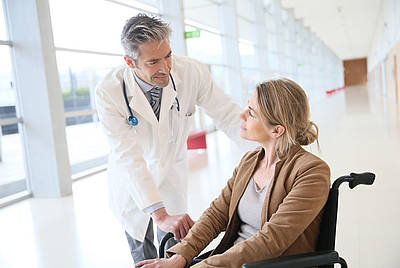Driving with a disability: Quadriplegia
Hand and arm function is severely or very severely limited. Due to extensive paralysis, there is virtually no back and chest musculature available for active use. This means that stability when seated is considerably reduced when driving round bends. Paravan offers restraint systems that can be adjusted in line with your needs and which support your head, back and thoracic regions. The limited strength and ability to move has a particularly negative effect on turning movements in the upper area of the steering wheel (in terms of the face of a clock: between 11 and 1 o’clock).
The inability to rotate the wrist affects the individual’s ability to start the engine with the car key and operate various controls (interval setting of the windscreen wiper on the indicator lever, light switch on the instrument panel, etc.). In addition, it is impossible for the wrist to assume a stable position. This makes it advisable to hold the wrist in place by means of a steering wheel caster fork or with a tri-pin on the steering wheel.
Our solutions
Paravan has developed steering wheels for disabled drivers and orthopaedic steering aids that are designed especially for individuals with physical limitations. These products enable quadriplegics to enjoy all the freedom driving has to offer.
Constantly restricted breathing reduces strength and causes physical performance to decline throughout the course of the day. This must be taken into account when measuring strength and movement.
Spasms that may shoot into the legs might cause the gas or brake pedals to be pressed inadvertently. It is therefore absolutely essential that the pedal system is covered. Paravan offers effective vehicle conversions to tackle these challenges.
Air conditioning is indispensable, as is auxiliary heating, since quadriplegics adapt to exterior temperatures and can therefore quickly become under-cooled or over-heated. For example, it is possible for a quadriplegic to die from heat exposure at temperatures above 40 degrees Celsius!
General categorisation according to height of paralysis (overlaps may occur):
C4
Usually only parts of the arm flexor (biceps) are available for active use; virtually no hand function.
C5
Arm flexor (biceps) are available; targeted use of the hand for holding and gripping can be practised and is required in order to be able to turn the steering wheel far enough when driving round bends.
C6
If limbs are kept in the right position in the phase immediately after injury, a passive closed fist and passive gripping of objects with the thumb and forefinger is possible.
C7
Arm extensor (triceps) is available – i.e. it will likely be possible to turn the steering wheel with little technical support when driving round bends.
C8
The muscles for bending the fingers are functional; nearly full hand function.
With our Space Drive II technology (drive/steer/brake-by-wire), we offer various driving aids in line with the degree of paralysis involved and the strength of the individual driver. This technology was developed by Paravan especially for people with disabilities who wish to become more mobile.
You’ll find further information on driving as a wheelchair user here. You can also contact us directly online – we’ll be happy to help you!
Definition
Motor paralysis of all legs and arms (quadri, Latin, means four)
Causes
Accidents involving fragmentation of the vertebral bodies and contusion or transection of the spinal cord (e.g. bathing accidents by diving into water of unknown depth); syringomyelia, tumour, gunshot or stab wound, diseases. Paraplegia involves similar symptoms.
Effects
Damage of the spinal cord between the 3rd and 7th vertebra (C 1-8). Partial quadriplegia or complete paralysis (quadriplegia) of both legs and arms with severe or very severe impairment of respiration and arm function.
Consequences
The musculature of both arms, both legs and the body is paralysed from the location of the transection of the spinal cord downwards. The existing muscles can no longer be tensed and moved deliberately. In the affected regions, there is no longer any perceptible sensation of pain, pressure, temperature, injury or touch. Owing to this loss of depth sensitivity, the affected individual can no longer localise the position of his or her legs if he/she is unable to see them. Bowel movements and the urge to pass urine can no longer be perceived, which means the bowels and bladder must be emptied at regular intervals by artificial means. The hands are slightly or largely limited in their function, manoeuvrability and strength. A rotating movement of the wrist is frequently no longer possible. As a rule, the biceps (flexor) is intact, which means active flexing and bending of the forearm can be controlled. The extensor muscle (triceps) is often impossible to reactivate. The arm can frequently only be extended passively by simply letting it drop down. The fingers can only grip by means of a special technique (functional hand). By constantly keeping the hands in a special position right from the beginning of treatment, the extensor muscles are shortened and a hand position is achieved that enables a passive fist to be formed, which in turn makes it possible to jam an object between the thumb and forefinger. Due to the paralysed muscles in the region of the ribs, only diaphragmatic respiration is possible. This inevitably causes a low lung volume, which in turn affects strength, resilience and motility and leads to sharp fluctuations in physical performance throughout the course of the day.


